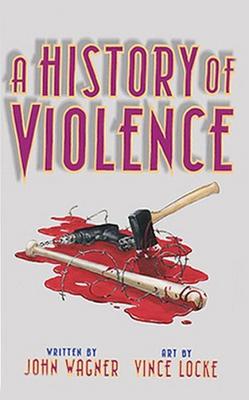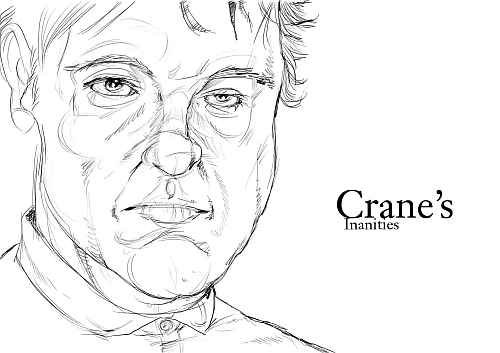 Firstly this week, I want to include a link to a trailer I saw Friday night that made me laugh really loud.
Firstly this week, I want to include a link to a trailer I saw Friday night that made me laugh really loud.Shining movie trailer. Watch the movie then read the background article. Pretty hilarious. Assistant Editor Makes Good.
Anyway. Saw three movies in the five days. I'll just talk about the one I saw last Wednesday, A History of Violence. Pictured to the left is the cover of the graphic novel the movie's based on. [There may be a spoiler or two, but nothing that's going to give away more than the trailer does].
I liked this movie quite a bit, but I’m not exactly sure why the critics are all going crazy for it, and calling it one of the year’s best. It doesn’t really seem to their taste. Their reactions to the film are all over the map, though they all seem to really like it. I think their positive reactions might be because the film seeks to reveal as much about the audience’s reaction to screen violence and the on-screen wish fulfillment of a hard and swift revenge, as it does to reveal the nature of violence itself; maybe this sort of ambition must have surprised and impressed the nation’s film critics. The movie’s about a guy named Tom Stall who lives out in the middle of nowhere with his wife (Maria Bello), his teenage son and his young daughter. He runs a diner in town, he’s in love with his wife (there’s a sex scene early on that made my audience break out in nervous titters), and he’s well-liked in town. He’s the guy who’s got everything that matters. So when two bad crime-spree types come into Tom’s diner to rob it (and off a few people in the process), Tom goes to work on them, and all of a sudden, his nice life in the country starts to unravel. The story of the diner incident goes nationwide and draws the interest of a cadaverous-looking guy named Fogerty (Ed Harris) who, with two hardcases in tow, pays Tom a visit at his diner, and insists in front of everyone that Tom is, in fact, someone else. This is all in the movie’s trailer. Where the movie goes outside of this framework is interesting.
A History of Violence is built around four scenes of ultra-violence that are grisly and frightening, but also completely thrilling. David Cronenberg, who directed the film, ably directs our emotions and our loyalties during these scenes as countless film directors have in the past, but in this movie, Cronenberg does it again and again just to make his point. For those who have seen Spider Man, I’ll offer an example: the scene in the high school when Peter Parker makes a fool of Flash, the school jock/bully. Great moment, and we all cheer because Flash so clearly deserved it because he’d picked on Peter earlier in the movie. Imagine a film that amplifies that scene by a factor of a hundred, and then replicates it over and over again to make up an entire film. That’s what A History is. Cronenberg makes you root for the violence. He makes you want it to happen, he makes you wish, when the violence is done, that it had been more cruel, the justice meted out harder, even slower. Because the people on the receiving end are always so grandly deserving of it – the filmmakers make sure of this (the bad guys are mean, they snarl and yell and try to kill our Tom), and when the rough stuff comes it is a visceral pleasure to watch. You don’t even shy away when they show the disgusting and bloody results of ultra-violence; you almost cheer. At least I did, but I'm kind of a sicko.
But at what point does the good guy meting out this justice become just another psychopathic murderer? At what point does the cheering audience become just another howling mob? At what point should we begin to question that primal urge in all of us to want to see those we’ve deemed to be bad or ‘evil’, (even if they are absolutely bad and evil), die? It’s also interesting that Cronenberg never changes the tenor of the scenes of violence. He never inserts an iota of moral ambiguity or complexity into these scenes. In the film there is never any doubt who is bad and who is good, who deserves their deaths and who is the righteous deliverer of justice. Because if there were more and more ambiguity with each scene of violence (as there is in a film like Unforgiven), the filmmakers would be making a far more mundane statement about violence and the nature of revenge: in essence, that revenge is an overly simple solution to a complex problem, and violence is never the right answer. But that’s a weaker statement than the one Cronenberg is interested in making because a) it’s obvious, b) it’s been made in countless other movies, and also c) because most of us never really perceive any complexity in issues of revenge and violence, so it has little real-world merit. After all, did the Hutus ponder the complexities of their anger towards the Tutsis in Rwanda before the killed them by the hundreds of thousands? Do the jihadists in Iraq ponder the complexities of their ire towards the US when they’re sawing heads off hostages? When Americans think of horrible evil people (Osama Bin Laden, Timothy McVeigh, John Wayne Gacy) our solution, indeed our government’s solution, is a form of legalized revenge that involves killing that person to get back at that person for killing whomever they killed. That’s our answer, but why is that our answer? Where does this new form of systematic violence against another person get us, and why do we find it satisfying? I think that, in part, this film is Cronenberg’s exploration of those kinds of questions. He seeks to dull our feelings of satisfaction at seeing a bad man get his just reward by making us numb to it. He does this through repetition. Develop, setup, payoff. Develop, setup, payoff. Again and again. Not to say that he doesn’t stage these scenes well or in a compelling way, but they are not significantly different from one another: they all result in bad deaths. By the end of the movie, we are nearly desensitized to the violence; even that cheer response ingrained into our lizard brains whenever we see righteous revenge meted out in movies, the cheer response mined to death by countless filmmakers, novelists, TV writers, is muted by the end of this movie. When the last bit of violence is done, we wonder what we got so excited about in the first place. A History of Violence is fascinating as much for what’s happening on-screen as it is a cinematic experiment that draws out the worst in all of us, and then asks us to examine that aspect of ourselves. It also happens to be really well-acted, well-photographed and well-written movie, so it can be enjoyed for lots of reasons.
I was going to go on and talk about Corpse Bride and Flightplan, but I went on and on about History, so I’ll save that for another day.

6 comments:
Not a lot of cross talk on History of Violence, eh? Oh well. I'll post something better tomorrow.
Der Speck -
I saw history of violence yesterday with my mother...yes my mother, sitting next to during those wonderful wonderful sex scenes...
Personally, I liked the movie a lot. But it did have the usual Cronenberg feel to it.
Corpse Bride...I liked as well, very technically amazing...but Nightmare Before Xmas is still better.
I haven't seen The History of Violence, yet, so I will hold off on reading your review of it until then.
need more posts
You're right about everything. Ever. I haven't seen it but I bet everything you said is right. I haven't seen the movie but I will once I get a date to pay for it.
Shawn, yeah, totally makes me respect Colbert a bit more, too, as if that's even possible. Also, do you think Colbert knows that Dumbledore dies on page 596 of the new Harry Potter novel? I'm just saying because, yeah I know Harry Potter and LOTR aren't exactly the same book, but if you like one fantasy turd then you like the next.
I hear too that it is Snape who kills him.
Post a Comment